With her slender, athletic look and distinctive ticked coat, the Abyssinian is a visually striking, loyal family addition.
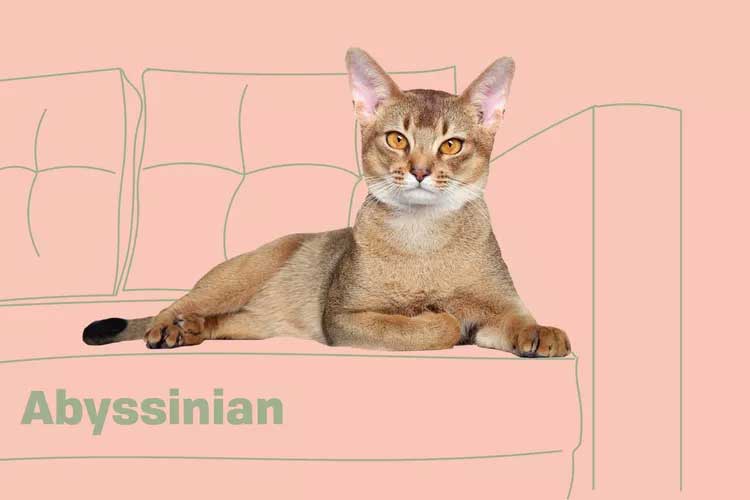
Abyssinian Overview
| OFFICIAL NAME | Abyssinian |
| COMMON NAME | Abyssinian |
| PET HEIGHT | 8 to 10 inches |
| PET WEIGHT | 8 to 12 pounds |
| LIFESPAN | 9 to 13 years |
| GOOD WITH | cats, dogs, families |
| TEMPERAMENT | sociable |
| INTELLIGENCE | high |
| SHEDDING AMOUNT | seasonal |
| PLAYFULNESS | high |
| ENERGY LEVEL | active |
| VOCAL LEVEL | when necessary |
| COAT LENGTH | short |
| COLORS | chocolate / brown / sable, fawn, red / orange |
| PATTERNS | tabby |
| OTHER TRAITS | easy to groom, easy to train, friendly toward humans, friendly toward other pets, strong loyalty tendencies |
Ancient. Enigmatic. Athletic. The word you're looking for is "Abyssinian." Currently one of the most popular cat breeds in the world, the Abyssinian, or "Aby" for short, is also one of the oldest, with origins shrouded in mystery.
Lithe, strapping, and deeply curious, Abys are beloved by owners for their almost dog-like desire to socialize and follow their people around the house. They're blessed with high intelligence and what seems like a motor that runs almost nonstop, making them natural explorers.
Appearance
The Abyssinian coat is her most striking feature, with its nuanced, complex ticking, which is a genetic variant of the tabby pattern. Her dense, close-lying fur starts lighter-colored at her body, then alternates between bands of lighter and darker shades out to the tip of her tail. A warm, reddish-brown base with black ticking is the breed's original color, but fawn is not uncommon.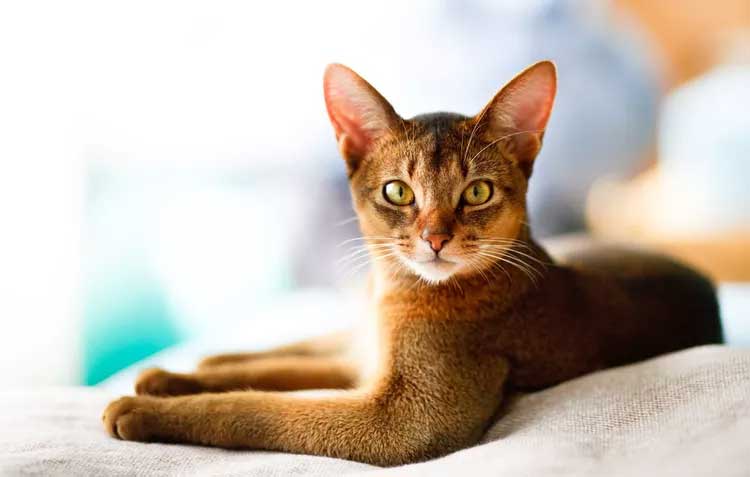
Outside of her beautiful coloration, the Aby's next most striking feature is her ears, which are large relative to her body, forward-facing, and well cupped. They sit atop a wedge-shaped head above large, alert, almond eyes.
An Aby's body is long and slender, giving her a particularly sleek and graceful look. Her paws are small, and the Aby's natural stance makes her appear to be standing on her tip-toes. Her tail tapers and is nearly as long as her body.
Temperament
Abyssinians are incredibly smart and curious, says Alison Gerken, DVM at Florida Veterinary Behavior Service. This makes them natural explorers, and you can expect to find your Aby in every corner of your home, on every possible surface, regardless of accessibility.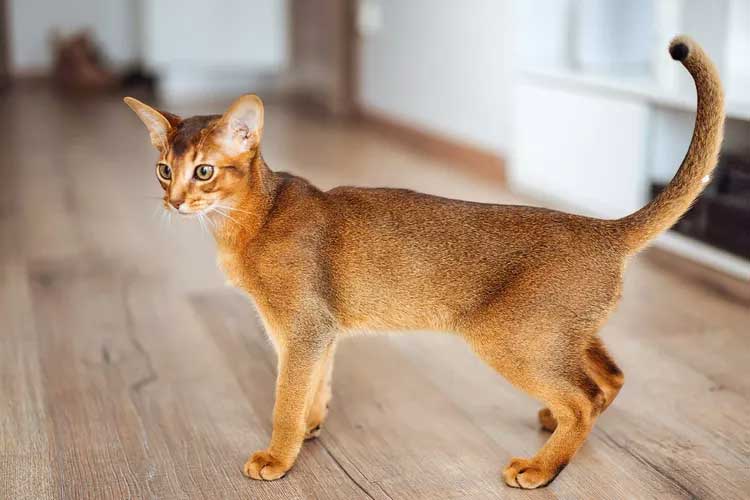
"They are very amusing but also need a lot of amusement," Gerken says "They are very athletic and love to climb, jump, run, leap, and explore. They can be challenging cats for pet parents who are seeking a mellow, snuggly, and laid-back cat or who are out of the home for long periods of time."
They are also renowned for their social abilities, and Abys enjoy spirited playtime with their people. Gerken says they are a breed that is always on the move, so don't expect a lot of lap-time from them, but do expect to have your every move followed and watched. Abyssinians are also keenly observant, so any treats or toys you secret away are apt to be discovered.
A strong companion cat, if not always a lap one, Abys enjoy the company of their human companions and will often converse with them in soft, pleasant churrups, rather than something akin to the traditional meow.
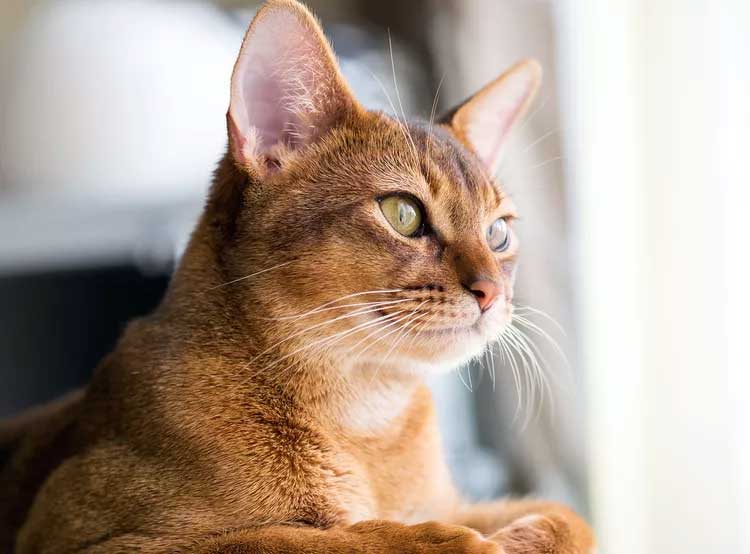
Living Needs
An Abyssinian is a cat who loves to get around and explore, and she is absolutely going to try and find her way up onto high shelves and vantage points. Multi-level cat trees, cat shelves, or scratching posts are greatly appreciated, as they'll give your Abyssinian ample opportunity to climb. If you have a large window and an easy perch for her to sit on, she'll enjoy watching (and chattering at!) the neighborhood birds throughout the day.Toys (and lots of them!) are also a must-have for an Abyssinian. These playful and smart kitties can become bored of the same old, same old. "They should be provided with a large variety of different types of toys—including toys that have feathers, toys that flutter, toys that bounce, toys filled with catnip, mechanical toys, and toys on strings—that are regularly rotated to provide novelty," Gerken says. They're also able to entertain themselves for extended periods of time with something as simple as a bottle cap or piece of rolled-up paper.
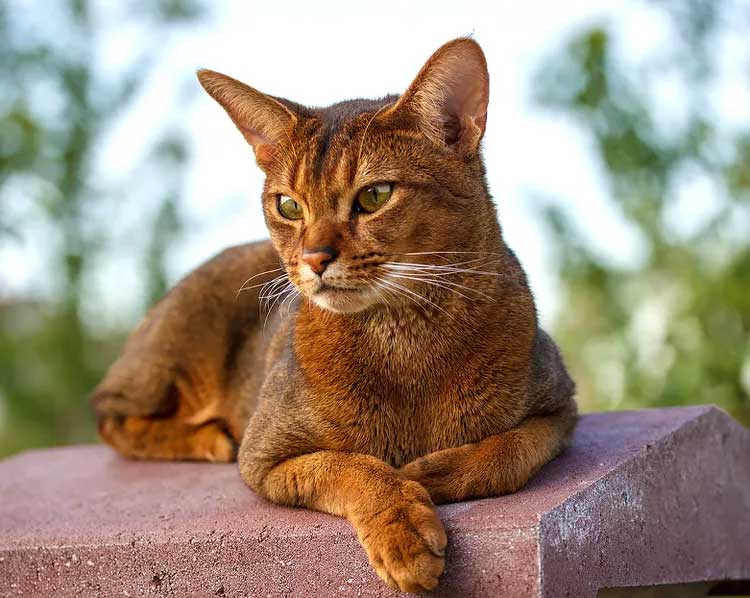
Abys do well in households with other animals, thanks to their naturally social disposition. But, Gerken says, "they often do not like to be picked up, cuddled, held, or restrained." If you have small kiddos at home, make sure they know how to properly interact with cats (no squeezing or tail-grabbing!).
Care
Abyssinians don't tend to be huge shedders outside of their regular shedding seasons, so daily grooming should be relatively straightforward. Weekly brushing is all they're probably going to need. Like all cats, an Abyssinian also needs access to fresh water and food, a clean litter box, and her claws kept neatly trimmed.And don't forget to care for their brains as well as their bodies; because Abyssinians are so smart, keeping them mentally stimulated is a vital part of keeping them healthy.
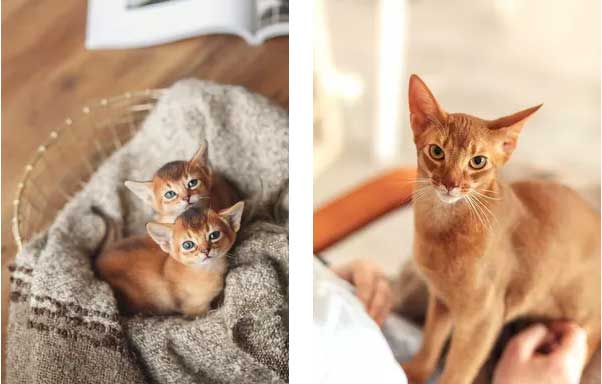
"Pet parents must provide a great deal of mental stimulation and enrichment to meet their needs and prevent the development of behavior problems that may stem from boredom, frustration, and under-enrichment," Gerken says. "They are cats who should attend kitten socialization classes when they are young and undergo training to learn cognitive skills that will keep them mentally engaged throughout their lives."
Gerken recommends giving your Abyssinian challenging food puzzles, or even hiding food around the house so they can search for it. Abys can also be trained to walk on a harness so they can safely explore the outside world.
Health
One of the things that makes the Abyssinian such a popular breed is her relative healthiness. But there are still some conditions pet parents need to watch out for, Gerken says, including:Progressive retinal atrophy: This refers to a group of genetic disorders leading to reduced or lost vision.
Patellar luxation: A kneecap dislocation that can range from mild to severe lameness. Surgery might be required to correct this condition.
Renal Amyloidosis: A genetic disorder in which deposits of a protein called amyloid build up in organs, particularly in the kidneys, which can lead to kidney failure.
Osteoarthritis: A painful joint condition that's common in all cats, especially as they age. Signs of osteoarthritis include difficulty jumping, running, or going up or down stairs; decreased energy; increased irritability; and if your cat stops using the litter box.
Kidney disease: Another common condition in aging cats, signs of kidney disease include frequent urination, increased thirst, dull or thinning hair, lack of energy, mouth ulcers, and vomiting.
Abys are also prone to gingivitis, which can lead to periodontal disease and tooth loss if not monitored. You can get into the habit of brushing your cat's teeth yourself (if your cat will let you; Abyssinians notoriously don't like to be handled).
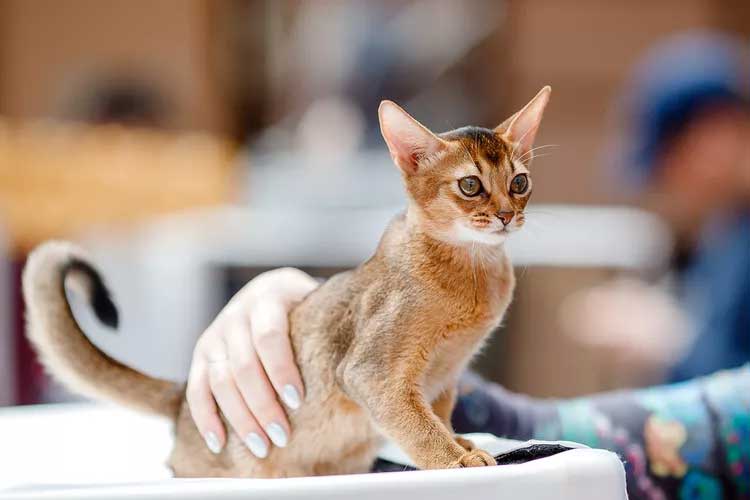
"You're definitely going to have to start when they're young," says Michelle Beck, DVM, CCRT, CVA, of the Backlund Animal Clinic in Omaha, Neb. "But honestly, it's still probably not going to happen. I have two cats and while brushing their teeth is a great idea, it's very difficult. Their mouths are very small; they're going to hate being held like that. Regular vet visits and professional dental cleanings at least once a year is a safer way to go."
History
Though the Abyssinian is one of the oldest known breeds, their exact origins have always carried an air of mystery. For a number of years, according to the Abyssinian Cat Club, it was popularly assumed they originated along the Nile river basin, and it's easy to see why: One look at an Aby in a seated position is enough to see the easy parallels between the breed and the statues and depictions of cats in ancient Egypt. However, more recent genetic studies have shown an argument for their origins to be Southeast Asia and the coast of the Indian Ocean.The oldest extant example of the cat that would become known as the Abyssinian is from the Leiden Zoological Museum in Holland, which has a taxidermied example that was purchased for the museum around 1834. That specimen is labeled "Patrie, domestica India", giving further credence to the cat's Southeast Asian origins.
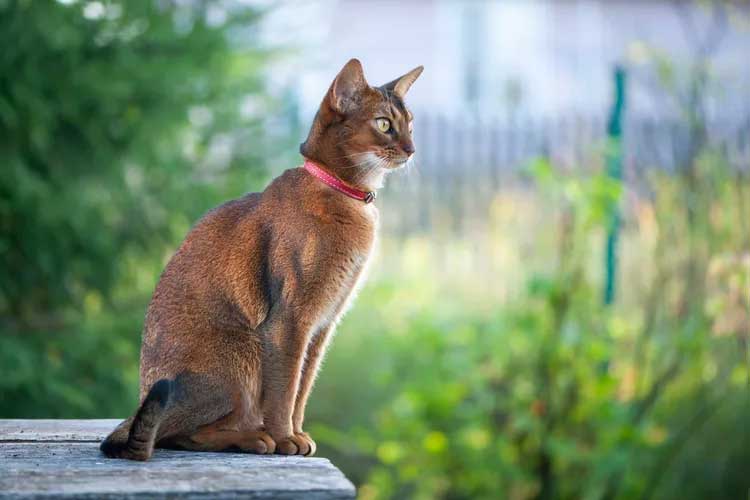
The name "Abyssinian" comes from Abyssinia (modern-day Ethiopia), from whence the cats who gave birth to the breed were brought to England after the Abyssinian War in the 1860s, according to the breed club. Those first cats featured the trademark ticked coats but were otherwise markedly different from today's Abys, with stockier bodies and shorter ears. Once they were settled in the U.K., cross-breeding with local cats eventually gave birth to the Abyssinian cat we know and love today.
Fun Facts
In 2007, the Abyssinian's DNA was decoded to help create a "rough draft" genome for the domestic feline. That decoding has helped our understanding of species domestication and provides insight into a number of feline diseases.An Aby was the titular feline in Disney's 1978 film The Cat From Outer Space.
The Abyssinian played a key role in developing Australia's first pedigreed breed of cat, the Australian Mist, which is a Burmese/Aby mix.